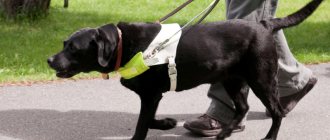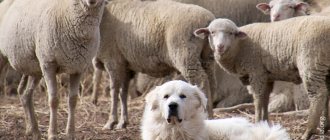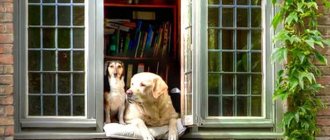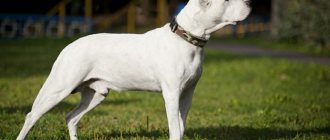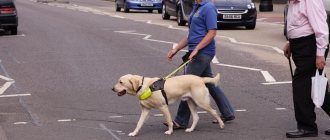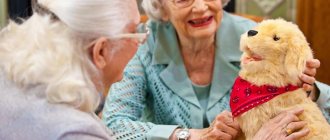If you turn to S.I. Ozhegov’s dictionary for the interpretation of the word “guide”, you can read that this is someone who helps someone walk, leads someone.
Dogs have mastered this good deed and have been helping people with disabilities feel supported and helped in difficult life situations for many years.
There is no specific breed that is ideal for working as a guide dog. As a rule, when selecting an animal, attention is paid to the basic innate qualities of character and receptivity to learning.
History of guide dogs
The concept of a “guide dog” first appeared in the 16th century. And the first special schools for training guide dogs began to open in the 20th century. in Germany at the end of the First World War.
Specially trained dogs helped veterans who lost their sight in the war. Then similar schools began to open in America, Great Britain and in the middle of the 20th century. in Russia.
According to the rules, guide dogs are called guide dogs.
The path to the dog
For visually impaired people of the first group, guide dogs are provided free of charge by the Social Insurance Fund. They are purchased at the request of an interested party within the framework of a government procurement program from the Russian School for Training Guide Dogs at the All-Russian Society of the Blind (RSHPSP VOS).
To submit an application, you must have an individual rehabilitation program in hand, in which a guide dog must be indicated as a “technical aid”. With this document you need to contact the Social Insurance Fund, submit an application, fill out a form, stand in line and wait for the call.
Dog_1 Labrador puppies in the kennel of the guide dog training school of the All-Russian Society of the Blind
Photo: TASS/Valery Sharifulin
The dog is selected individually for each person, depending on his physical characteristics and wishes. Waiting times can vary greatly.
Andrey Ivashkov, Deputy General Director of the Russian ShPSP VOS for Social Issues
In general, the wait is not long, but sometimes people want a dog of a certain breed or color. The school offers four breeds: German and East European Shepherds, Labrador Retrievers and Golden Retrievers. According to the school's regulatory documents, color, gender and breed do not affect the functional purpose of the dog, but if possible, we will accommodate. However, you need to understand that the waiting period will increase.
Natalya Bakhvalova was lucky. The call that radically changed her life came the very next day.
— Owners of guide dogs have groups and chats. Everyone tells different stories. Some wait two years, others not a day. I filled out the application and indicated that I wanted a male Labrador, chocolate-colored and not too hairy. The very next day they called me from the school and invited me to come for a two-week training,” the girl recalls.
Dog_6
Guide dog at the guide dog training school of the All-Russian Society of the Blind
Photo: TASS/Valery Sharifulin
Training is a mandatory step before a dog is adopted by a person with special needs.
Andrey Ivashkov, Deputy General Director of the Russian ShPSP VOS for Social Issues
The training lasts 12–14 days. Disabled people do not bear a financial burden: the Social Insurance Fund pays for their travel and the accompanying persons, and we take care of accommodation and food. For the period of training, a disabled person is individually assigned an instructor who teaches how to manage a dog, we also provide veterinary and certain legal knowledge. We issue all the necessary documents and a set of equipment for the dog, plus, upon application, the Foundation pays the disabled person an annual monetary compensation for the maintenance and veterinary care of the guide dog.
Tailed friend: the bravest four-legged heroes of our days
Are dogs capable of feats?
However, not everyone can go this route. In some regions, such a “technical aid” as a dog is reluctantly prescribed, citing the lack of training centers, long waits and other reasons. In this case, those who still decide that they need a guide can contact a second institution - the dog training institution. Here it is enough to provide a medical certificate confirming visual impairment.
Unlike the school, this center exists mainly through donations, but even there you can get a dog for free and with all the documents.
— We select the dog individually. We study the person’s physical capabilities and parameters in order to understand the required dimensions and temperament of the dog, and see whether the person will have the opportunity to care for it, including financially. The waiting period for a dog is now a year and a half. Then we also invite you to training. We provide accommodation and meals free of charge during this time, but, unfortunately, we cannot take on tickets for now. We receive federal subsidies, but they only cover a quarter of expenses,” explains center representative Elina Pochueva.
Dog_4
A guide dog during training on a treadmill at the guide dog training school of the All-Russian Society of the Blind
Photo: TASS/Valery Sharifulin
Crazy aroma: schizophrenia is recognized by smell
They will search for patients with dangerous mental illness using dogs and chromatographs.
There is an opportunity to get a dog for free, albeit with a wait. However, not everyone decides to do this. Even together, the two institutions manage to produce about 100 tailed assistants in a year. And this is for the whole country.
Responsibilities of guide dogs
Guide dogs are trained in various skills. One of the main responsibilities is the protection of the owner in a public place.
- A guide dog for the blind can guide its owner along the safest route, skillfully avoiding obstacles and warning the owner about stairs, tree branches, fences and other restrictions. Dogs not trained in this skill do not pay attention to various obstacles.
- In addition to all of the above, these animals undergo perfect training, have the ability to pick up and hand fallen things to the owner, and help to get out of public transport.
Another skill that is taught in training courses is refusal to obey if the owner is in danger. Guide dogs know how to make decisions.
Rehabilitation with soul
According to experts, the reasons are different. First of all, lack of information.
“When an individual rehabilitation program is being developed, they may not even mention this possibility. Some are told that there are no dogs, others that they are not allowed, because you yourself can navigate,” Pochueva shares with Izvestia.
The same could have happened with Natalya Bakhvalova. She could not even think that a person who has lost his sight could become the owner of a dog until she met such a couple in person.
Natalya Bakhvalova
For myself, I didn’t even consider this option until I came to Moscow for courses. Here I met a completely blind woman from Novosibirsk, and she had a guide dog. I was amazed that she fearlessly, relying only on the dog, navigates even in unfamiliar terrain.
Dog_3
An instructor at the guide dog training school of the All-Russian Society of the Blind trains a guide dog to work on the route
Photo: TASS/Valery Sharifulin
Before the Labrador Lux appeared in Natalya’s life, the girl did not leave the house without the help of a sighted person: “I don’t feel confident with a cane: am I going there? With Lux, I know for sure that even if we get lost, he will definitely lead me out, I won’t accidentally go out onto the road, I won’t fall into a manhole. With him you feel like an absolutely complete person.”
Such help is especially invaluable for those who have experienced vision loss during their life.
Natalya Bakhvalova
I lost my sight at the age of 21, studied at a regular school, managed to work, and led a normal lifestyle. It was difficult. I had to overcome myself and continue to live. And when a guide dog appears, you’re no longer in the mood for “oh, that’s bad, I don’t want to hear anything, leave me alone.” This wet nose will wake you up in the morning: “Why are you lying there? Get up, let's go for a walk." A dog is rehabilitation with a soul.
Memory of Naida
History of the Far Eastern Hachiko
Breeds suitable for the role of guides
In order to become a guide, a dog must have certain character traits. But in reality, in practice you can understand which dogs are guide dogs and which are not.
For the most part, large, hardy breeds are easier to train than other animals.
The best guide dogs are animals with the following character traits:
- Resourcefulness and intelligence.
- Restrained character, the ability to restrain innate abilities.
- Resistance to stress.
- Excellent eyesight and sense of smell.
- Loyalty to the owner.
Getting a dog used to a permanent owner
Those few weeks that last the third stage of training a guide dog - handing over the trained animal to the owner - are a very important period for both of them. It is at this stage that it will become clear whether the dog and the person are suitable for each other.
A guide dog is trained to drive a person over several months (usually about eight). The person did not receive such preliminary preparation. And, using the help of specialists, he is still often forced to act in relations with his guide on a whim. After all, the dog handler at this stage accompanies the dog and the person, but is not close to them, but follows the couple at some distance.
The owner should spend as much time as possible with his four-legged guide. Use praise, offer treats in case of some success, talk to the dog more often, accustoming it to the sounds of your voice. There are cases when the owner and the dog do not suit each other, but they are extremely rare.
Collie
A collie is a dog with an innate instinct to protect its owner.
- Animals of this breed are brave and determined, but at the same time warm and good-natured, they get along well with children, so they can become their best helpers.
- They are medium in size, which is an important quality for guide dogs.
- They are highly trainable, do not pay attention to extraneous sounds, and are not distracted by what is happening around them.
Golden retriever
From the photos of guide dogs it can be seen that they all have similar traits.
- The Golden Retriever is a breed that is trained to support visually impaired and blind people more often than others.
- By nature, these dogs are very docile, and during the hunt they can bring live prey to the owner without injuring it.
- They are brave, intelligent, observant, submissive animals.
Their only drawback is their long hair, which can make it difficult for a blind owner to care for. But if the owner finds a way to care, then a golden retriever is the best option for both children and adults.
Labrador
These are friendly, easy to train animals and are considered the best guide dogs. Due to their characteristics, it will not be difficult for them to switch from the instructor to the owner and establish a connection with him.
- This is a companion animal and has good stress resistance.
- Labradors are brave and friendly.
- They are very calm, and most blind people choose them.
- In addition to all these qualities, they have good health and live up to 18 years.
- This breed exhibits virtually no hostility; they communicate well with adults and children.
The training of these animals takes place effortlessly, up to about one and a half years. Another advantage of Labradors is their ideal size, thanks to which it will be easy for the owner to hold on to the harness.
What breeds are suitable as guide dogs?
It so happens that the best breeds of guide dogs for the blind are considered to be Labradors, Shepherds, Collies, Rottweilers, Dobermans and others. In fact, the breed is not the key factor, since the dog must meet a number of other equally important characteristics. Its physical characteristics are also important, because the animal must be the right size for its owner.
German Shepherd
The dog has unique intellectual abilities; it can learn commands quickly and in large quantities - learning them will only require a few repetitions. The animal's intelligence goes well with loyalty, a kind and cheerful disposition. Thanks to their natural courage, shepherd dogs are used as watchdogs and rescuers: for example, they come to the aid of water disasters, fires, and to search for those lost in the mountains. It is important that the animal shows kindness and affection not only to the owner, but also to the children. The dog is also tolerant of other animals. However, trainers and dog handlers note that now shepherd dogs are less often used as guide dogs, since the breed has become more sporting and exhibition.
Collie
Like all herding breeds, collies have a genetically strong instinct to protect their owner, as well as small children. They are distinguished by their good disposition, activity, and devotion. This breed is especially often trained as a guide dog for children. The main advantages of this breed: lack of fear of street noise and busy traffic; quick orientation even in unfamiliar terrain; the ability to subtly sense the needs and desires of its owner.
Labrador
If you describe the character of a dog in one word, then “friend” refers specifically to this breed. The Labrador is very prudent, calm, and easy to train. The average height of the dog reaches 56 cm, which facilitates comfortable movement on the street. According to statistics, 80% of people with visual impairments choose this breed as a guide. For small children, such a dog can replace a nanny. The Labrador responsibly fulfills the tasks assigned to it. The lifespan of a dog is from 12 to 18 years.
- Cat claw attachments
- Dog
- Long-eared cats
- Cat meowing
- Alexandrian parrot
- Why does a cat need a mustache?
Golden Retriever
The dog's character is very friendly and flexible. The breed has proven itself to be good companions, children's favorites, and helpers. Dogs can often be found in police or customs service due to their keen sense of smell. The Ray Retriever is a smart dog, quickly remembers all commands, is trainable, hardy and flexible. This breed is suitable for the role of a guide dog or water rescuer. On average, the Golden Retriever lives up to 15 years.
Rottweiler
The Rottweiler dog breed is the most loyal, strong, and resilient. Thanks to its physical characteristics, it can serve as a guide, guard, or rescuer. Externally, the dog is very large, with a wide chest and neck, height from 60 cm to 70 cm. Very smart, trainable. Such a dog needs a strong-willed mentor or owner. Because of his manic devotion and jealousy, he can harm others. It is recommended that the animal be taken outside on a leash and muzzle.
Doberman
It is better to purchase such a dog as a guide dog for a child. The Doberman is a kind of perpetual motion machine. You need to play and walk with him a lot. Children will be very happy with its constant mobility. He will fit very harmoniously into any family, becoming its full-fledged member. By nature, they are very calm, approach strangers with caution, and quickly determine whether their charges are in danger.
Dobermans are able to adapt to their owner's mood. During the game, they can remember any commands and carry them out with precision in the shortest possible time. Such dogs grow up to 72 cm and weigh up to 50 kg.
Boxer
If Boxer dogs are properly raised and trained, they become excellent rescuers and guide dogs. Animals are very friendly towards others, if you do not set them up in an aggressive direction. They will always come to the rescue if they feel a threat to the owner’s life.
Based on the structure of their body, dogs are suitable for people of short stature, disabled people, as well as children. They do most of the work at home, which is suitable for people with disabilities. All commands are easily understood, they are quickly remembered, and their further execution occurs automatically, even without a reminder. The dog is small in size. Its height reaches up to 57 cm, weight – up to 45 kg.
Giant Schnauzer
At first glance, it is difficult to imagine such a giant as a guide. The dog's height is from 60 cm to 70 cm, and its weight is 50 kg. But Giant Schnauzer dogs are strong, brave and resilient. They have a well-developed sense of protection. In any situation they will come to the defense of the owner.
These dogs are very hardworking and patient. The main difference between the Schnauzer and other dog breeds is its phenomenal memory. Dog experts say that this is the smartest dog breed. Animals will become ideal companions for blind people, and will also brighten up the gray days of your children.
Royal Poodle
The list would be incomplete without the Royal Poodle. Kind and unpretentious, he is ready to serve his master until his last breath. Poodles are easy to care for and train, so they are suitable even for inexperienced owners. It is impossible to get bored with this dog: the poodle will support any game and will happily meet family friends. But, if the owner needs help, this dog will do everything possible to make him happy.
German Shepherd
This breed is distinguished by good mental abilities and loyalty.
- Their intelligence and tenacity make them well suited for the role of a guide dog, and their courage makes them good guard dogs.
- Their resilience helps them work in even the coldest conditions, but unlike Labradors, they need more time to bond with their new owner.
Rottweiler
In the past, when Labradors were not so popular as guide dogs, Rottweilers were often used.
- In addition to loyalty, they have courage and perseverance.
- They need serious training and education, thanks to which they make excellent guide dogs.
- In addition to guides, they are excellent guards.
- These dogs are suitable for people with a strong character, as they may tend to be dominant.
Doberman
Dobermans are very playful animals, so it is best to choose them for children.
- These dogs need to be walked and played a lot.
- A distinctive feature is calmness, as well as wariness towards strangers.
- Their advantage is that they adapt to the owner and guess his mood.
Stages of training guide dogs
- Dogs are trained from 1.5 months. Already at this age, instructors select contact puppies. The main requirements are that the dog must tolerate any noise well and not show its instincts too much.
- At 6-7 months, dogs begin to be driven around the city and come into contact with people. Dogs need to show themselves in a friendly manner in response to touch, since otherwise the future visually impaired owner will not be able to come into contact with him.
- At the last stage, the dogs are trained according to the correct behavior of guide dogs. From the age of one to one and a half years, special training begins. It involves learning the “fetch” command, moving with the future owner along a given path, and the ability to avoid obstacles. This stage ends with a kind of exam for the dog with two instructors: one of them wearing special glasses that deprive him of vision, and the second observing the accuracy of the guide dog’s work.
What documents are required to obtain a dog for the blind?
To be eligible to receive a guide dog, a disabled person must provide the following documents:
- application in any form with a request to prepare a guide dog. It can be filled out on the website of one of the two organizations mentioned above;
- questionnaire;
- medical certificate confirming visual disability;
- scanned copy of your passport.
Copies of documents must be sent by mail to the required address. After receiving the application, employees will contact the disabled person or his relatives and begin work on processing the order. They will listen to your wishes regarding the breed of the dog, and also clarify the conditions in which it will live. Since both the School and the Center are located in the Moscow region, workers often personally visit people who contact them from nearby cities. Communication with residents of other regions of Russia takes place by telephone and email. In this case, you need to answer the questionnaire in as much detail as possible, on the basis of which the staff will select and train the dog. Animals undergo training according to a standard program, but in addition, each of them can acquire the skills necessary for the specific person for whom it is being prepared.
The capabilities of a guide dog
A guide dog may disobey its owner and make a decision on its own if it sees that the owner is in danger. She can stop when a car approaches them, protecting herself and her owner.
A guide dog cannot distinguish between the colors of traffic lights and cannot explore unfamiliar territory. Its task is to guide its owner along a given path in the safest possible way.
Mutual responsibility
For some, small compensation that does not cover expenses and problems with the accessibility of the environment can be an obstacle. Such difficulties do sometimes arise.
— Most of the blind people still work as massage therapists. It would be necessary to provide premises in organizations, even small ones, in which one could leave a dog. It’s one thing if a person, for example, works as a lawyer in his office, and a dog can calmly be with him, and another thing in a massage therapist’s office. Wool, smell. What if you have an allergy? What if a child comes and might be scared? Yes, the dog is not scary, but it’s big,” says guide dog owner and journalist Veronika Filippova in a conversation with Izvestia.
Dog_2
A visually impaired woman during the first meeting with her guide dog at the guide dog training school of the All-Russian Society of the Blind
Photo: TASS/Valery Sharifulin
For those who want to get themselves a shaggy assistant, the willingness to defend rights can come in handy at any time. And at the entrance to public transport, and in various institutions. But in addition to rights, the owner also has responsibilities.
Veronica Filippova
A dog is included in the list of technical means of rehabilitation, but, believe me, it is not a technical means. This is a living organism. As the instructor told us, this is a three-year-old child who will never grow up. My dog is five years old, she is good and smart. Having a dog reduces the stress for me. If someone dug a hole on the road overnight, I don’t need to strain myself to find it, the dog will tell me. But I feed her, I sing, if her illness goes away, I take her to the vet. This requires both moral and physical readiness. A disabled person must be independent, be able to navigate, and take care of not only himself, but also the dog.
A responsible owner, Izvestia’s interlocutors are sure, remembers that not only he, but also those around him have rights. And if the infrastructure does not yet help in finding a compromise, then the owners themselves have to take care of this.
Dog_5
An instructor at the guide dog training school of the All-Russian Society of the Blind trains a visually impaired woman to work with a guide dog
Photo: TASS/Valery Sharifulin
— I always advocate that the dog should be muzzled, wearing a collar, with a leash and harness. Of course, we are required to be allowed into public places, but I myself will not go to the same supermarket with my dog. Therefore, racks should be provided, for example, with a video surveillance system, says Veronika Filippova.
The owners of guide dogs most often expect banal tact from those around them. The main principle to be followed is do no harm.
The cost of the animal and the right to receive
Guide dogs are provided free of charge to everyone with group I visual impairment. But you will have to wait your turn, which usually takes about 6 months. For those who don't want to wait, you can buy an animal.
The price for a guide dog ranges from 250-400 thousand rubles. The second option is to purchase the animal yourself and send it to training. The cost of training is approximately 60 thousand rubles.
Blind people receive guide dogs absolutely free of charge.
But how much money do we actually spend on preparing it?
We have slightly changed the official version of calculating the cost of training a guide dog. Now it is 746,487 rubles. Since expenses have increased compared to the old estimate, we believe that explanations are needed.
Some expense items have increased due to price changes. Veterinary and medical drugs (we also use them to treat dogs) have become noticeably more expensive. Puppies have become more expensive, we do not exceed the amount of 40 - 50 thousand, which is now considered low. Prices for food and treats have also increased.
But the main changes in the estimate are caused by a new approach to its preparation. With rare exceptions, all our programs and projects require co-financing. The total cost of the dog, approaching a million, discourages potential benefactors. It is explainable. ONE (just one!) dog is given to ONE blind person. And the thought of how much useful can be done not only for this one person, but for many other blind people in this million, inevitably arises. And the arguments: “once a trained dog helps a blind person for many years, changes his life, brings him back to life...” pales in comparison to the harsh one with six zeros. Therefore, we have always used an estimate that is acceptable for most of our projects, adding co-financing items to it, if required by our partners. In the current, very, very difficult conditions for us, we decided to present the real picture. First of all, to make it clear what the organization’s annual budget consists of, which we voice when we say how much money we need to do our job and continue to help.
All budget items are the costs of training a guide dog. Some of them are obvious, understandable without comment: training or food. Some need clarification, “decoding”. Such as the mentoring program, which allows us to support our alumni across the country with personal visits, or the volunteer program, in which all of our puppies are raised and socialized into families. As you probably noticed, the estimate does not reflect administrative and general business expenses, without which the existence of the organization is, in principle, impossible. As required by law, they do not exceed 20%. But this does not make them more popular or more attractive to philanthropists. This is a touchy subject for most nonprofits.
Let us only add that we spend our funds economically and thoughtfully. Finding and using all available options to reduce costs. 746,487 rubles is a considerable amount, but behind every ruble in it there is a qualitative change in a person’s life, this is exactly what we are working for.
